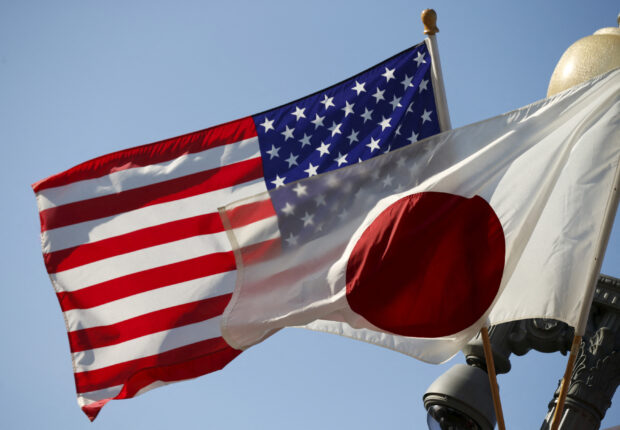
FILE PHOTO: The U.S. and Japan flags fly together outside the White House in Washington April 27, 2015. REUTERS/Kevin Lamarque/File Photo
TOKYO/WASHINGTON — U.S. President Joe Biden and Japanese Prime Minister Fumio Kishida will agree next month to tighter military cooperation, including talks on the biggest potential change to Washington’s East Asia command structure in decades, two sources said.
Washington will consider appointing a four-star commander to oversee its forces in Japan as a counterpart to the head of a proposed Japanese Self Defense Forces (SDF) headquarters overseeing all of the country’s military operations, said the sources, who have direct knowledge of the plan.
READ: PH, Japan, US to hold first ever trilateral leaders’ summit on April 11
Biden and Kishida will unveil their plans when they meet on April 10 in Washington, the Financial Times reported.
“We are in discussion about how our planned joint command can strengthen cooperation with the U.S. and South Korea,” Japanese Chief Cabinet Secretary Yoshimasa Hayashi said on Monday at a regular media briefing when asked about the reports.
The agenda for the Biden-Kishida summit has not yet been decided, he added.
Kishida wants to establish the joint command headquarters before the end of March 2025. Tokyo has said it has “serious concern” over China’s growing military power and the threat it poses Taiwan, just over 100 km (62 miles) from Japanese territory.
Unlike in neighbouring South Korea, where U.S. and South Korean troops can operate under a unified command under a four-star general, U.S. air, land and sea forces in Japan have a three-star commander and do not have any authority over Japanese troops.
READ: PH, Japan, US discuss trilateral cooperation in Tokyo ahead of April 11 summit
A four-star commander – the highest peacetime rank in any of the U.S. service branches – would match the rank of the Japanese counterpart in the new headquarters. A U.S. officer of that rank might lay the groundwork for a future unified Japanese-U.S. command, experts say.
Some U.S. officials, however, want any new U.S. commander there to be responsible only for joint exercises, training and information sharing with the new SDF headquarters, said one of the sources, both of whom asked not to be identified because they are not authorised to speak to the media.
The White House, the U.S. National Security Council and the State Department did not immediately respond to Reuters requests for comment.
The Pentagon on Monday said U.S. Defense Secretary Lloyd Austin met with Japanese National Security Advisor Akiba Takeo.
“The two officials highlighted areas for further Alliance momentum in support of a free and open Indo-Pacific region,” a Pentagon statement said after the meeting.
Japan is crucial for U.S. military power in Asia, hosting 54,000 American troops, hundreds of aircraft and Washington’s only forward-deployed aircraft carrier strike group. The bases on Japanese islands allow the United States to project military power across the region and hem in Chinese influence.
Closer cooperation between the two allies comes as Japan steps away from the post-war pacifism that has shaped its defence planning for decades.
At the end of 2022, Japan pledged to double defence spending to 2% of gross domestic product, including money to procure cruise missiles that can strike ships or land-based targets 1,000 km (620 miles) away.